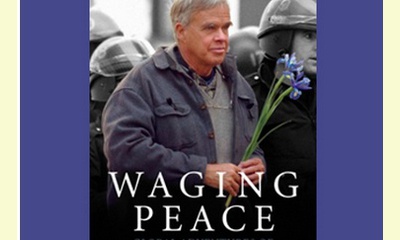|
|
Giants on the Earth: A Review of Waging Peace by David Hartsough
un articulo por Winslow Myers, World Beyond War
There were giants on the earth in those days . . . (Genesis 6:4)
The fear that we citizens of the United States have
been seduced into since 9/11 spreads across our benighted nation
like a fog, inhibiting all policy alternatives not based in blind
vengefulness. Special are those who have the spiritual clear-
sightedness and persistence to make people-oriented global
connections that pierce the fog of fear with the light of visionary
possibility. 
click on photo to enlarge
One such giant is David Hartsough, whose vivid, even hair-raising,
memoir of a lifetime of peace activism, Waging Peace: Global
Adventures of a Lifelong Activist, has just been published by PM
press. It ought to be required reading for every U.S. citizen
befogged by the crude polarization between Islamic extremism and
the equally violent, ineffective, but seemingly endless Western
military reaction it has elicited.
It hardly seems possible that Hartsough has been able to crowd into
one lifetime all his deeds of creative nonviolence. He was there with
Martin Luther King in the late fifties in the South. He was there when
a train loaded with bullets and bombs on their way to arm right-
wing death squads in Central America severed the leg of his friend
Brian Willson in California. His initiatives of support for nonviolent
resistance movements span both decades and continents, from
efforts to get medical supplies to the North Vietnamese, to
reconciliation among Israelis and Palestinians, to support for
Russian dissidents as the Soviet Union was breaking up, to the
resistance to Marcos in the Philippines, and on and on. Hartsough’s
book thus becomes a remarkably comprehensive alternative history
to set against “the official story” of America’s—and many other
nations’—often brutal and misguided reliance upon military
intervention.
David Hartsough gave himself a head start by getting born into the
right family. As a boy he heard his minister father preach the gospel
of loving your enemies and almost immediately got a chance to try
it out when bullies pelted him with icy snowballs. It worked, and
Hartsough never looked back. Having determined to do integration
in reverse by attending the predominantly black Howard University,
he soon found himself sitting in with courageous African-American
students at segregated restaurants in Virginia. A white man crazed
with hate threatened him with a knife. Hartsough spoke to him so
gently that the man was “disarmed” by the unexpected shock of a
loving response and retreated open-mouthed and speechless.
Sixty years of innumerable protests, witnesses, and organizing
efforts later, Hartsough is still at it as he helps to begin a new
global movement to end war on the planet, called “World Beyond
War.” While his book is a genuinely personal memoir that records
moments of doubt, despair, fear of getting shot, and occasional
triumph, even more it is a testament to the worldwide nonviolent
movement that still flies completely under the radar of American
media.
(This article is continued in the discussionboard)
|








|
DISCUSSION
Pregunta(s) relacionada(s) al artículo :
Have you read this book? , If so, should it be on the culture of peace reading list?
* * * * *
Comentario más reciente:
:
Here is the table of contents of the book, Peace: A World History:
Table of Contents
Introduction - How Does Peace Have a World History?
Chapter One - Survival of the Peaceful: Prehistory to the First Civilizations
Pre-Human Peace and Peacemaking
Prehistoric Evolutions of Peace
Peace, Peacemaking and the First Civilizations
Chapter Two - Peace in the Ancient West: Egypt, Greece and Rome
A Tale of Two Worlds: Peace and Peacemaking in Ancient Egypt
Ancient Greece, Cradle of Western Peace and Peacemaking?
One Empire, One Peace: The Rise of Rome to the Pax Romana's Decline
Chapter Three - Peace in the Ancient East: India, China and Japan
The Many, the Few, the One: Peace and Peacemaking in Ancient India
Harmonies and Antinomies of Ancient China
Foreign Influences and Native Peace in Japanese History
Chapter Four - Monotheistic Peaces: Judaism, Christianity and Islam
Shalom: Peace in the Torah and its Times
"Our" Universal Peace: From Christ to Constantine
A Pillar of Peace: The Qur'an and its World
Chapter Five - Medieval, Renaissance and Reformation Peaces
A Tale of Two Cities: Medieval Peace and Peacemaking
(Re)Births of Peace: Renaissance Revivals of and Departures from Traditions
Reforming Christian Peace and Peacemaking
Chapter Six - Peace, Peacemaking and the Ascent of Nation-States
Intra-National Peace and Peacemaking
Inter-National Peace and Peacemaking
Peace and Peacemaking Despite Nation-States
Chapter Seven - Colonial and Imperial Peace and Peacemaking
Peaces of the World: Colonial Peace and Peacemaking
The World in Peaces: Imperial Peace and Peacemaking
Chapter Eight - Modern Economics of Peace and Peacemaking
Capitalism: The Profitability of Peace and the Cost of War
Who Owns Peace? Socialist Perspectives
Chapter Nine - Peace in the Twentieth Century, Part One: 1900-1949
The "War to End all Wars"
The Peace to End all Peace?
Chapter Ten - Peace in the Twentieth Century, Part Two: 1949-1989
Cold War/Hot Peace
One World, Many Peaces
Chapter Eleven - The Presents of Peace
Globalization: Peace at the End of History
Threatening Opportunities: Terrorism, Technology, New Media and Peace
Conclusion - The Pyramid of Peace: Past, Present and Future
Selected Bibliography
Works Cited
Index

|
|









